Retell Stories of the Ancient: Fu Chin Revived Song Dynasty Ceramics
"Song dynasty ceramics, the most wondrous of their kind, are as precious as morning stars, glowing until the end of the world." - Qianlong Emperor, Qing Dynasty.
Renaissance of Celadon Ceramic
Chen Yinke, one of the pioneers of China’s May Fourth Movement, once stated: “The Chinese civilization, after eons of evolution, reached its peak in the Song dynasty. Despite its decline afterwards, the glory of the culture will surely be revived in due course.” From Chen’s quote, we may see the culture of the Song dynasty is regarded as the turning point of Chinese civilization. Both the classical Song poetry and Song ceramic are irreplaceable spiritual heritage throughout history.

Warming bowl with celadon glaze, Ru ware, Northern Song Dynasty
Collection of National Palace Museum, Taipei
Ru ware pottery in the Song dynasty is widely known for its bluish-green glaze and is considered the best of celadon ceramics. Due to its high quality and low quantity, Ru ware was used by the royals in the Northern Song dynasty. The applied craftsmanship is unprecedented, and only a limited number of Ru ware ceramics have been passed down to the present. There are only 77 Ru ware ceramics preserved in the world to date, and 21 of them are collected in the National Palace Museum. Due to its rarity like morning stars, Ru ware ceramic represents the unique charm of art in the Song dynasty, telling its preciousness with its hue and shape.

Narcissus basin in bluish-green glaze, Ru ware, Northern Song Dynasty
Collection of National Palace Museum, Taipei
The National Palace Museum is renowned for its collection of Chinese antiques and artifacts. It has over 20,000 porcelain collections in total, presenting the unsurpassable height in Chinese porcelain art, and most of them were passed down from royal predecessors of the Qing dynasty. Among 25 celadon ceramics from official kilns of Northern Song dynasty and 118 from Southern Song dynasty, the Ru-ware celadon ceramics from Northern Song are adored treasures for domestic and international collectors. The jade-like glaze, purple stained foot ring, and eel-blood crackle, all the unique attributes were naturally created during the making with no further effort by craftsmanship. To promote the art of celadon ceramic and enable viewers to bring the artifacts back to their homes for pleasure, National Palace Museum collaborated with Fu Chin Ceramic, specializing in celadon ceramics with aesthetic charm of Ru ware in Northern Song dynasty, and initiated the renaissance of celadon ceramic.
Revive the Beauty of Ancient Palace
Known as “the first of celadon”, Ru ware ceramic from the Northern Song dynasty had an absolute short period of time for production throughout history. The passed down artifacts are so rare and precious that they have been deemed as scarce treasures even in the Southern Song dynasty. Hence, since 2015, Fu Chin Ceramic has collaborated with National Palace museum and released 8 replicas of Song dynasty treasures, including Warming bowl with celadon glaze, Narcissus basin in bluish-green glaze, and Mallet vase with bluish-green glaze from Northern Song Ru ware, as well as Hibiscus-shaped bowl in celadon glaze, Floral-shaped brush washer with celadon glaze, Water-chestnut flower-shaped dish with celadon glaze, Chrysanthemum-shaped dish with celadon glaze, and Long neck vase with celadon glaze from Southern Song official kilns.
The craftsmanship of Fu Chin is highly recognized by the National Palace Museum. Inspired by the classic potteries of the Song dynasty, Fu Chin revived the unique glaze and design of Ru ware and official kilns from the two dynasties after hundreds of times of visits, material collecting, analysis, design, and making. New in look, yet old in spirit, the refined crafts, free from the boundaries of time, went through cautious inspection conducted by the national museum. Now, the ceramics are ready to re-display the elegance of royals in the ancient time.
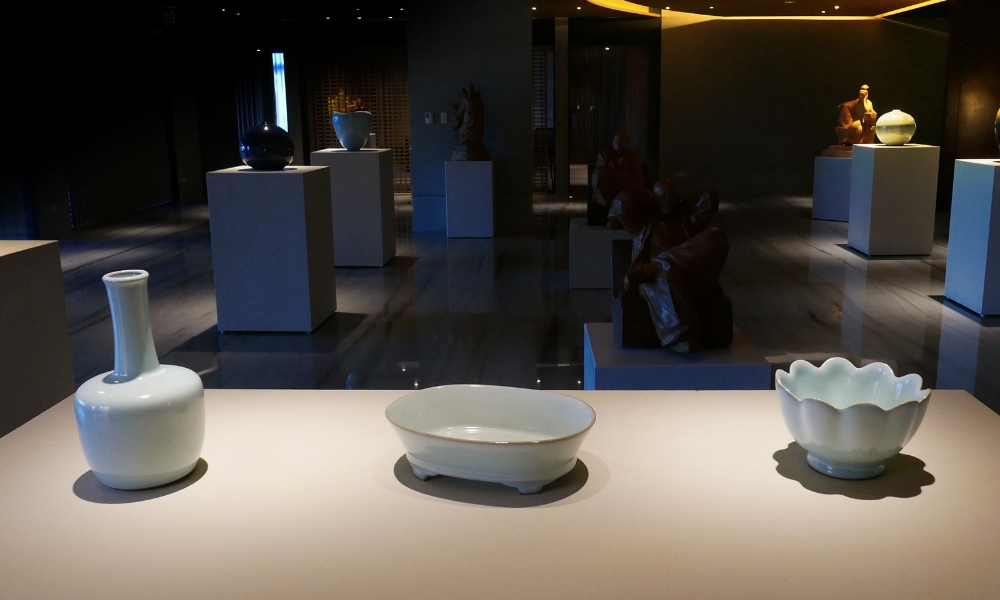
The three treasures of the Song dynasty are (from left to right)
Mallet vase with bluish-green glaze, Narcissus basin in bluish-green glaze, and Warming bowl with celadon glaze
Warming bowl with celadon glaze, Narcissus basin in bluish-green glaze, and Mallet vase with bluish-green glaze are the most representative works among Ru ware ceramics in the Northern Song dynasty. They were registered as national heritages by the Ministry of Culture in 2019. In addition to their frequent displays at various exhibitions, they all belong to crucial artworks in the collection of National Palace Museum; therefore, they were the very first three artworks to be replicated among the 8 selected artworks.
Warming bowl with celadon glaze has petal-like walls and slightly splayed mouthrim. The main body is wide on the upper part while narrow on the lower part. With the support of the foot ring, the bowl resembles a blooming lotus flower in shape. Dark stained rim, pinkish glow, and denim-colored ceramic body, all the elements besides the bluish-green glaze bring the ceramic to a new height in aesthetics, elegance and vibrance. This warming bowl is the only Ru ware artwork passed down from the Northern Song dynasty. Thanks to its undamaged shape and ethereal design, the bowl is a representative work of perfection in pottery art.
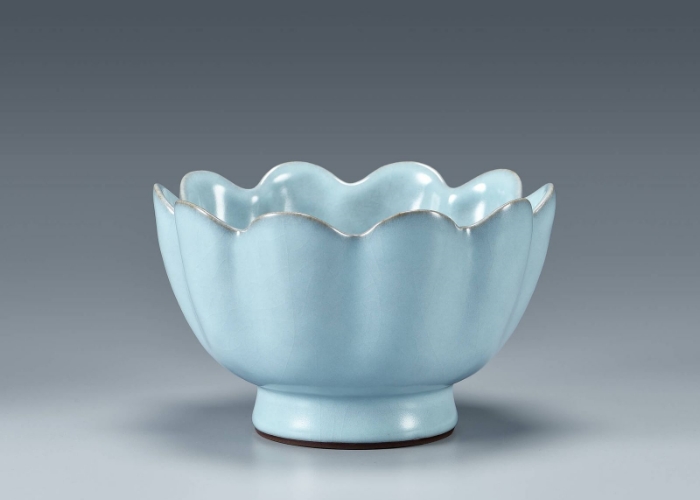
Warming bowl with celadon glaze, Fu Chin
The original work of Narcissus basin in bluish-green glaze has already been highly appreciated by its artistic value. The replica by Fu Chin has four delicate cloud-shaped feet attached to the bottom of the oval basin as support. Then, the wall of the basin gradually widens from the bottom to the top to form an outspread mouthrim. The seamless attachment of the two components stuns viewers, as it enhances the visual display in a dedicated yet simple manner. The bowl is known for its clean bluish-green glaze with no crackles, which is an attribute of scarcity.
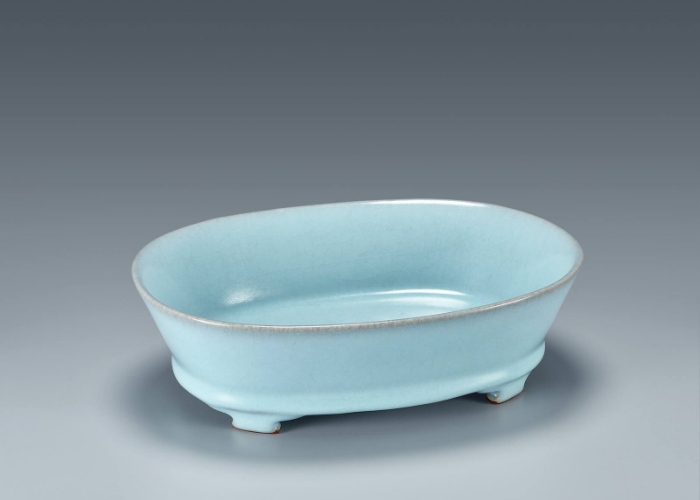
Narcissus basin in bluish-green glaze, Fu Chin
Lastly, Mallet vase with bluish-green glaze is inspired by Feng-Hua mallet vase with bluish-green glaze, one of National Palace Museum’s collections. The original artifact has five spur marks as well as an inscribed imperial poem, “Ode to the Ru Kiln Vase”, by the Qianlong Emperor. At the end of the poem, an inscription reads, “Written by the Emperor in midsummer of the 43rd year of the Qianlong reign (1778 CE)”. Furthermore, the inscription is accompanied by two seals, respectively stating “Guxiang (vintage aesthetics)” and “Taipu (natural and simple)”. On the left side of the poem inscribed a seal with two characters “Fenghua”, where viewers can see Qianlong’s opinion on Ru ware ceramics.
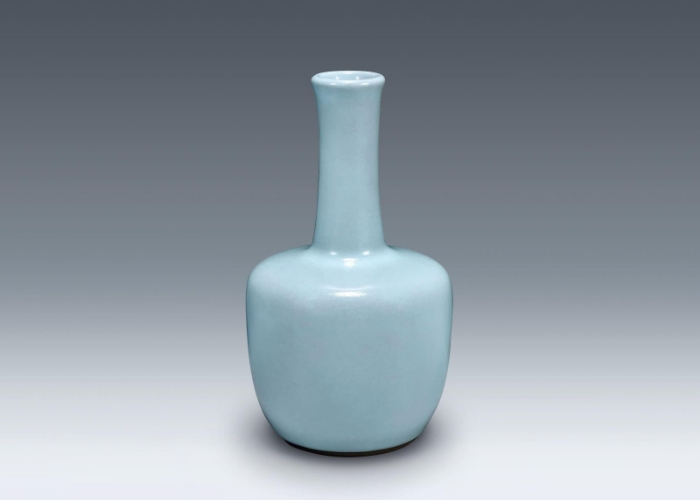
Mallet vase with bluish-green glaze, Fu Chin
Unlike scarce Ru ware ceramics from the Northern Song dynasty, artworks from Southern Song official kilns have higher quantity and diversity. While Southern Song official kilns artifacts are generally famous for large-sized ceramics, Fu Chin selected a few exquisite and refined daily life objects such as a cup, bowl, and long neck vase, respectively for drinking tea, placing pastries, and putting flowers, to make life more enjoyable. In contrast to Northern Song artifacts, the five replicas of the Southern Song dynasty by Fu Chin are meant to blend the vintage beauty into daily life. Hibiscus-shaped bowl in celadon glaze is characterized by a curve going up and down on the lip. The design of the wall corresponds to that of the lip, resembling a six-petaled flower. The artwork is firm in texture and elegant in look. The delicate celadon glaze with a hint of pink color accentuates the warmth and chic of the ceramic.
Floral-shaped brush washer with celadon glaze imitates one of the essentials of traditional Chinese study rooms: brush washer. The light, refined pinkish celadon glaze highlights the delicate crackles. The detailedly designed shallow dish makes the washer a pleasantly stunning curio with advanced craftsmanship.

Hibiscus-shaped bowl in celadon glaze, Fu Chin
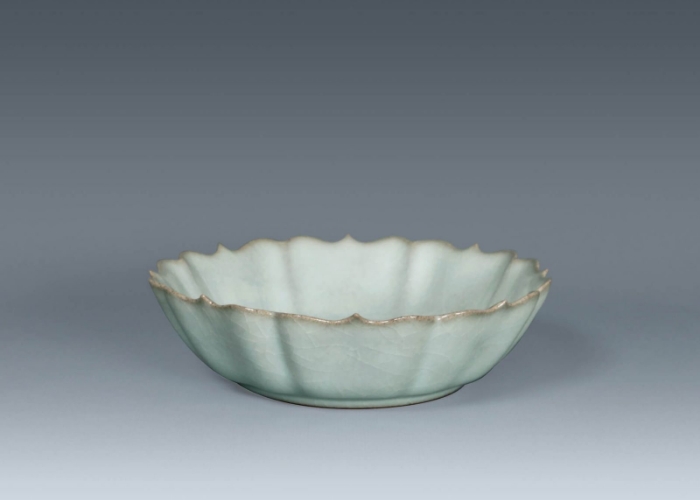
Water-chestnut flower-shaped dish with celadon glaze, Fu Chin
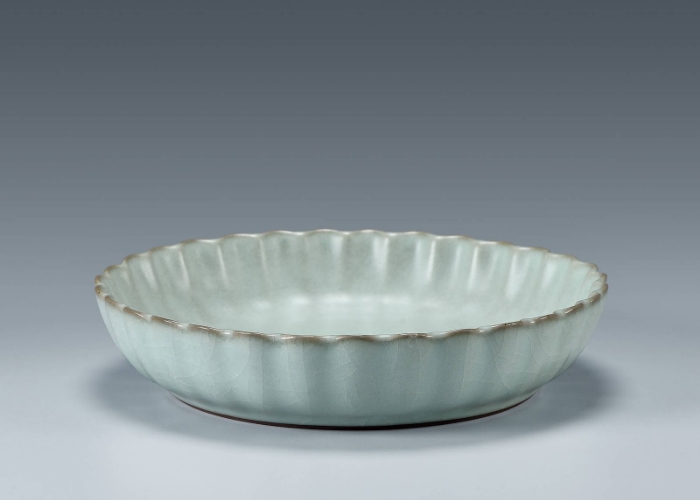
Chrysanthemum-shaped dish with celadon glaze, Fu Chin
Other artworks featuring a short foot ring include Chrysanthemum-shaped dish with celadon glaze and Water-chestnut flower-shaped dish with celadon glaze. The former is a replica of the chrysanthemum-shaped dish from the Southern Song dynasty, characterized by its pinkish celadon glaze, exclusively fired by Southern Song official kilns, as well as 31 ridges of chrysanthemum petals, shaped by pottery mold. Innovating the ancient art, Fu Chin revived the vintage elegance of the artwork with a thin ceramic body and thick coating. As for the latter, the ceramic is presented as an eight-petaled blooming water chestnut flower with splayed mouthrim, short wall, flat bottom, and shallow foot ring. Covered in pinkish celadon glaze, the ceramic has beautiful dark stained rims naturally exposed after dedicated carving and coating. The thin layer of coating on the ridges glints pinkish glow. With delicate crackles spread throughout the whole ceramic, viewers may discover more details of ice crackles when viewing at a close distance.
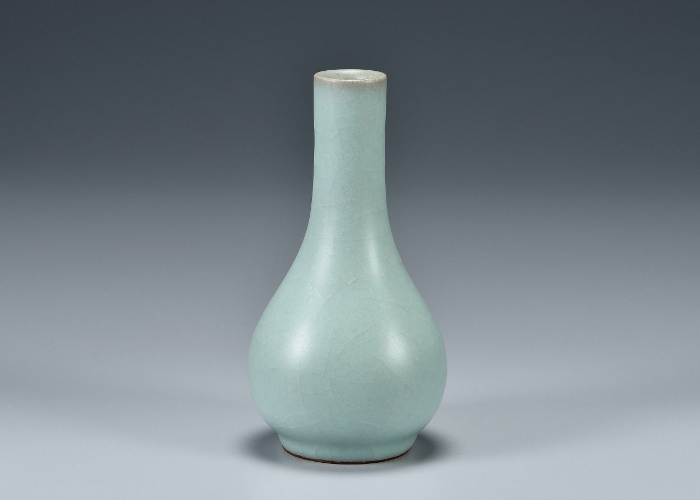
Long neck vase with celadon glaze, Fu Chin
Furthermore, Long neck vase with celadon glaze is the most admired one among the ceramic replicas. Dainty mouthrim, thin neck, suave curves, slender shoulder, and plump belly, all the details make the vase full-bodied and stable. The 6:4 ratio of the upper and lower part in length, with delicate and round design, have the vase become a representative work of simplicity. The extending curves growing upward properly display elegance, as they create a harmony with the surrounding environment all in silence.
Know the Past and See the Future
Despite the end of the project, the collaboration between Fu Chin Ceramic and National Palace Museum have made the celadon ceramics from Song kilns widely popular among the existing collections of the museum. The reason is believed to be the fantastic craftsmanship of Ru ware and its impressive scarcity. The celadon glaze with pinkish glow on the thin parts of coating is the main feature of the ceramics’ posh and luxurious charm. Every time the Song ceramics are exhibited in large-scaled international auctions, they are always sold at skyrocketing prices. The collaboration successfully duplicated the elegance of the lost art in the Northern Song dynasty.
The “three treasures of the Northern Song dynasty” are detailedly recorded as digital collections of the National Palace Museum, thereby proving the cultural importance of Warming bowl with celadon glaze and Narcissus basin with bluish-green glaze as exhibits in the museum. Fu Chin sincerely welcomes collectors to make appointments for visit via our official website or phone call. Besides having classic curios for private use, each work includes a box and guarantee. The ceramics are the optimal choices for gifting and decoration. Fu Chin will continue to create more ceramic works in hope of making celadon ceramic more prevalent and therefore ascending the artistic value of it.
Fu Chin also stated that the lifestyle of an artist is full of challenges. It’s hard to maintain the identity as an artist because art is subjective, distinctive, and the creator truly needs support from confidants; thus, Fu Chin advises that once you love a work, never give shy to give compliments, as they not only encourage the creator, but also give the true meaning of art.
About Fu Chin
Introduction
Fu Chin, an artist dedicated himself to creating exquisite celadon artworks and ice crackle celadon. He wishes for people to find serendipity from within the heart, and enjoy every moment of life, feeling all the great things around them, by indulging themselves in the beauty of celadon.
Whilst having only 15 years of experiences, he has created the artwork with the highest price in National Palace Museum, in a collaboration with the museum. He has received numerous awards in exhibitions in Taiwan, China and Japan. In 2020, on his 3rd year of joining Japan Traditional Kogei Association, Tokai branch, his celadon creation was given an award by the association. He is also the first Taiwanese in the association.
Revive the Classics with National Palace Museum
Contact
T . +886-4-2461-6901
E . [email protected]
A . No. 5, Ln. 128, Fuya Rd., Xitun Dist., Taichung City
w . https://fu-chin.com.tw/
FB . https://www.facebook.com/DTceladon
Related Articles
2023 FGU International Summer School!
Welcome to Fo Guang University's 2023 International Summer School! We are excited to invite international students to join us for a two-week program from June 25th to July 8th.
Aesthetic Experience in Virtual Gallery of Fu Chin Ceramics
Ceramics in the Song dynasty is the most glorious chapter throughout the history of pottery. The spirit of scholar-officials and Zen Buddhism not only cultivated advanced civilization of the society, but also achieved the simplicity and elegance of Song ceramics. That is, Song celadon ceramics suitably present the most intricate standards of refined beauty in the purest form, shown by multiple aspects of the works such as the shapes, glaze, and texture. When it comes to appreciation of celadon ceramics, viewers have to observe the subtlest details, from light and shadow to crackles, to feel the dedication of the potterist.
A New Place for Relaxation: Yuli in Hualien County, Taiwan
Rice, tea leaves, and orange daylily, Yuli Township, Hualien, gathers precious agricultural resources, awarded by several competitions. To improve tourism in Yuli, the Small and Medium Enterprises Administration, Ministry of Economic Affairs, initiated the “New Life in Pusko” project to promote excellent products via a digital cluster consisting of 10 local enterprises. The project is aimed to make Yuli a new popular tourist destination of Hualien with joint digital marketing campaigns.